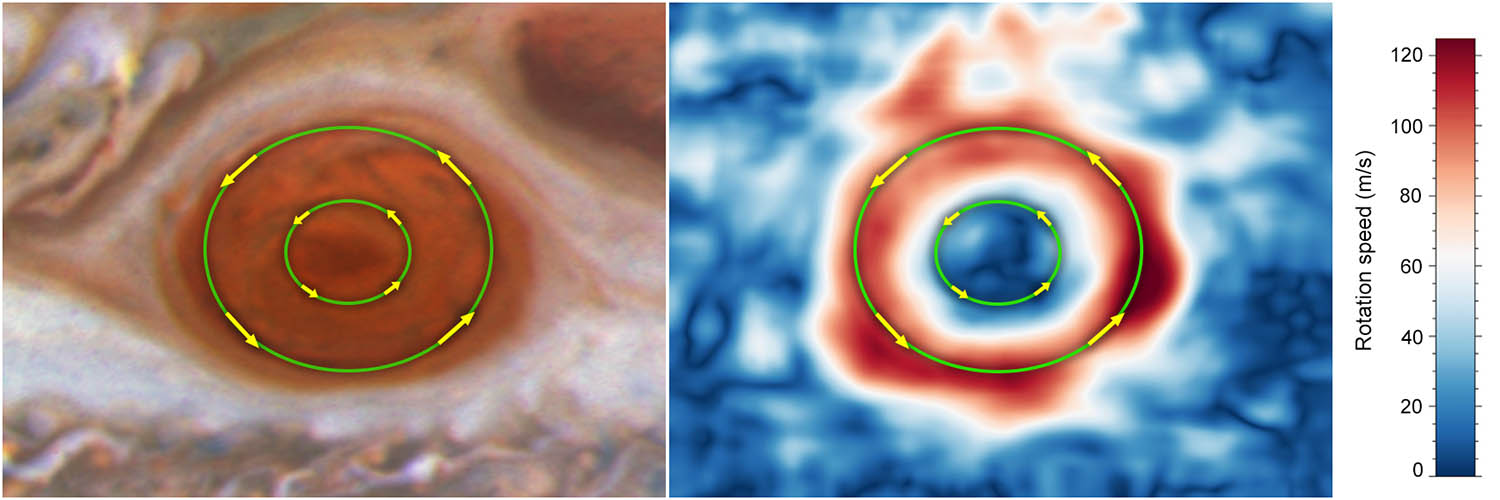STScI: Hubble Shows Winds in Jupiter’s Great Red Spot Are Speeding Up

By analyzing images taken by NASA’s Hubble Space Telescope from 2009 to 2020, researchers found that the average wind speed just within the boundaries of the Great Red Spot, set off by the outer green circle, have increased by up to 8 percent from 2009 to 2020 and exceed 400 miles per hour. In contrast, the winds near the storm’s innermost region, set off by a smaller green ring, are moving significantly more slowly. Both move counterclockwise. CREDITS: SCIENCE: NASA, ESA, Michael H. Wong (UC Berkeley)
Like the speed of an advancing race car driver, the winds in the outermost “lane” of Jupiter’s Great Red Spot are accelerating – a discovery only made possible by NASA’s Hubble Space Telescope, which has monitored the planet for more than a decade.
Researchers analyzing Hubble’s regular “storm reports” found that the average wind speed just within the boundaries of the storm, known as a high-speed ring, has increased by up to 8 percent from 2009 to 2020. In contrast, the winds near the red spot’s innermost region are moving significantly more slowly, like someone cruising lazily on a sunny Sunday afternoon.
The massive storm’s crimson-colored clouds spin counterclockwise at speeds that exceed 400 miles per hour – and the vortex is bigger than Earth itself. The red spot is legendary in part because humans have observed it for more than 150 years.
“When I initially saw the results, I asked ‘Does this make sense?’ No one has ever seen this before,” said Michael Wong of the University of California, Berkeley, who led the analysispublished today in Geophysical Research Letters. “But this is something only Hubble can do. Hubble’s longevity and ongoing observations make this revelation possible.”
We use Earth-orbiting satellites and airplanes to track major storms on Earth closely in real time. “Since we don’t have a storm chaser plane at Jupiter, we can’t continuously measure the winds on site,” explained Amy Simon of NASA’s Goddard Space Flight Center in Greenbelt, Maryland, who contributed to the research. “Hubble is the only telescope that has the kind of temporal coverage and spatial resolution that can capture Jupiter’s winds in this detail.”
The change in wind speeds they have measured with Hubble amount to less than 1.6 miles per hour per Earth year. “We’re talking about such a small change that if you didn’t have eleven years of Hubble data, we wouldn’t know it happened,” said Simon. “With Hubble we have the precision we need to spot a trend.” Hubble’s ongoing monitoring allows researchers to revisit and analyze its data very precisely as they keep adding to it. The smallest features Hubble can reveal in the storm are a mere 105 miles across, about twice the length of the state of Rhode Island.
“We find that the average wind speed in the Great Red Spot has been slightly increasing over the past decade,” Wong added. “We have one example where our analysis of the two-dimensional wind map found abrupt changes in 2017 when there was a major convective storm nearby.”
